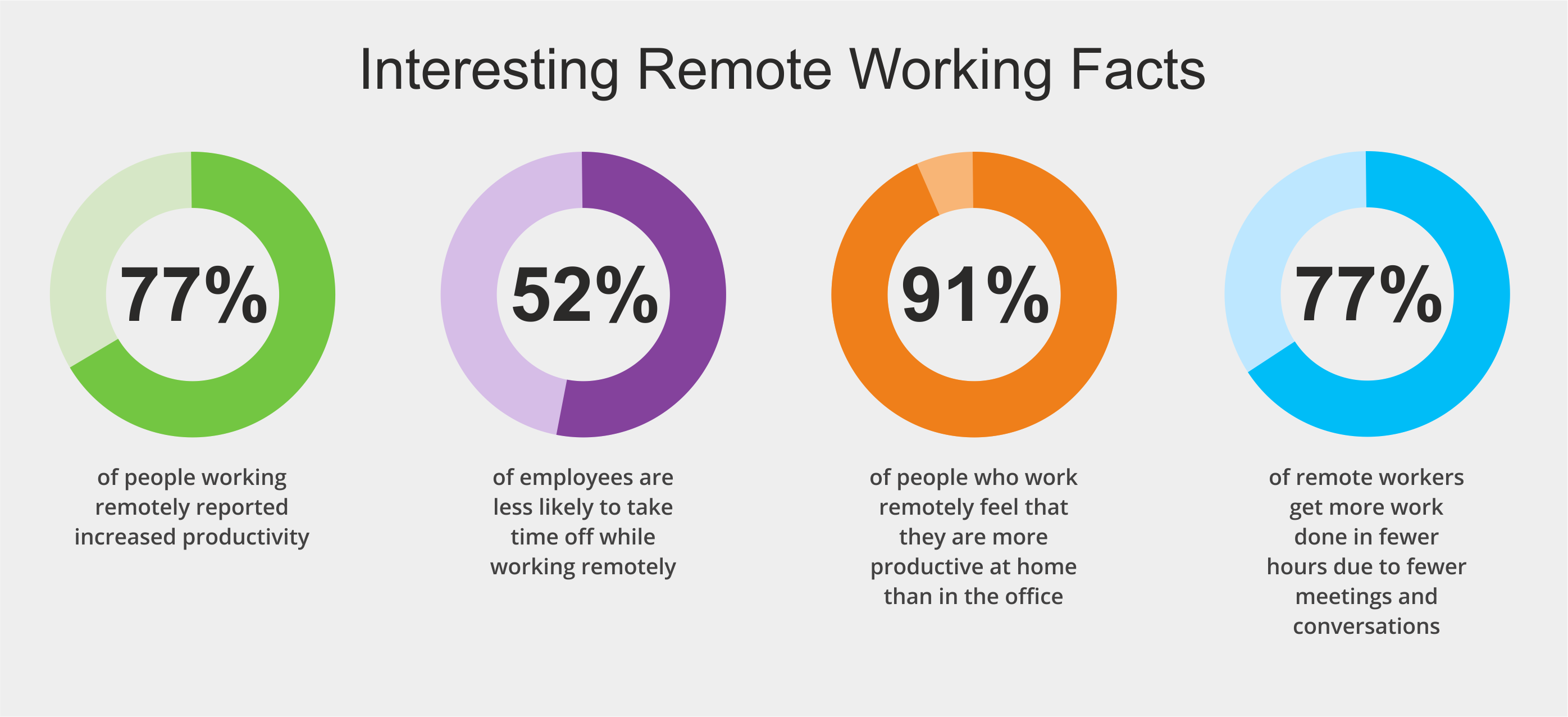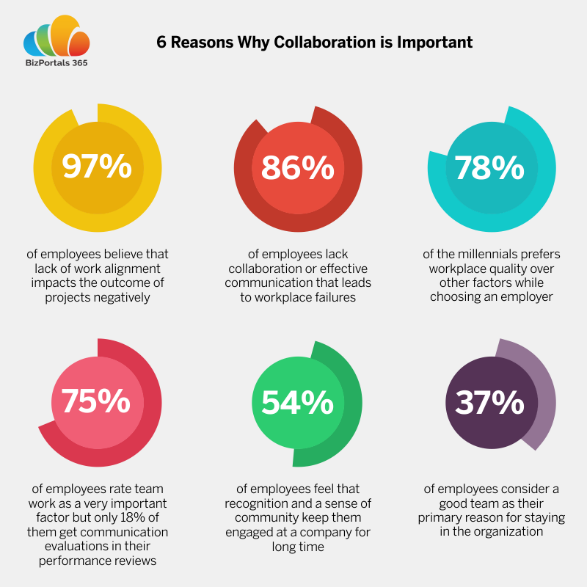
What is the Importance of Collaboration in the Workplace?
The Internet has changed the workplace forever. Today we have technology, and the digital workplace has revamped how businesses are being operated and how teams work on a global scale. Laptops, smartphones, tablets, and cloud technology have given rise to remote working and allow teams to work more efficiently.

Since the workplaces are becoming increasingly digital, it is necessary to understand –
- How can businesses manage workplace collaboration in this new era?
- How can digital workplace contribute to collaboration?
With the rise of remote work, distributed teams, and virtual offices, the digital workplace has become the new normal.
And the key to survive and thrive in this new era is a “collaborative workplace”. Let’s understand what collaboration means and more.
In this post, we will look at:
- What is collaboration in the workplace?
- Why is collaboration in the workplace important?
- What are the benefits of collaboration in the workplace?
- Tips to improve workplace collaboration
- How BizPortals 365 enhances collaboration in the workplace?
The development of modern technologies has not taken away the need for humans to interact with each other. We still need to collaborate effectively to complete a variety of tasks. Forget the days when the workplace referred to a physical office space occupied by the employees during regular working hours. The new-age workplace is confined simply to a laptop screen. The work culture is more flexible. The employees like to be heard and wish to share knowledge across the organization. Business ideas are discussed and shared beyond the usual workgroups.
And to match these changing needs of employee work experiences, they need a collaborative workplace to gain and share knowledge, communicate seamlessly, work effortlessly, bring productivity, efficiency, growth, and innovation.
Read on to discover what collaboration is in the workplace, why collaboration is important, tools and tips to encourage workplace collaboration, and more.
What is collaboration in the workplace?
Collaboration involves a group of people sharing their skills and ideas with the purpose of achieving a common objective. The workforce with different perspectives, ideas, and expertise work together to find innovative solutions, which in turn help the organizations to solve problems in a more efficient manner. Collaboration can happen in any type of setting whether teams are stationed at an office or working remotely. The goal of a collaborative workplace is to maximize the possibilities of success by administering a communicative and collaborative experience across the organization.
Why is collaboration in the workplace important?
Every individual has different skills, talents, and expertise. When all the team members collaborate, they can utilize their knowledge, skills, and experience to achieve the shared goal. Collaboration also helps in tracking project deliveries as employees combine their expertise to get things done in the workplace. It also allows employees to share their ideas while understanding how they think, work, and operate. This in turn, can be mutually beneficial for employees as well as the organization.

However, achieving effective collaboration is never easy. Just an assortment of remote works does not necessarily make an effective digital workplace. May be there are too many employees working remotely, may be the departments of your organization are siloed, or most meetings are unproductive. The key is to empower the employees with the right workplace collaboration tools so that they can collaborate effectively across the organization.
What are the benefits of collaboration in the workplace?
1. Promotes a problem-solving approach
Workplace collaboration means making a pool of knowledge, skills and bringing varied talents together. When experienced people are brought together, teams will have a better problem-solving approach. Let us say you have made a lot of progress on the project but encountered a roadblock while the deadline is approaching rapidly. Now, you might schedule a brainstorming session with your team to ask for different perspectives and ideas. So, collaboration is the last resort to solve the problem at hand.
2. Enhance learning opportunities
Collaboration ensures the opportunity to learn from the success and failures of the team members. This is one of the best benefits of collaboration in the workplace as people can bring different skills and backgrounds to the table. Learning from team members is not only a benefit of collaboration but is also the first step towards building a learning culture in the workplace. The teams can learn from their mistakes, successes, failures, pain points, workflow, etc.
3. Higher employee productivity and participation
Working independently has its own benefits as we can focus on the project without any distractions. But for many projects, collaboration makes the work more efficient. When the projects are complex and highly demanding, group effort is mandatory. And that’s where enterprise collaboration comes into play. It help in dividing up the heavy workload, finding innovative solutions to tough problems, and wrapping our heads around the bigger picture. When working on projects together, collaboration in the workplace ensures equal participation of team members.
4. Enable seamless internal communications
Employee collaboration creates a more cohesive and open workplace as it maintains regular and direct communication with team members. It also helps you gain valuable insights into different departments and be able to resolve problems quickly. Like, an intranet on Microsoft 365 is an excellent collaboration tool to do just that. It is designed to open varied communication channels across the organization.
5. Eliminate organizational silos
If you find that teams in the organization rarely interact with each other and operate in isolated silos, you might want to put together a mixed skills team. For example, a product designer, a developer, a user experience designer, and a content writer. So, when you bring together members from different teams to achieve a common goal, you have used collaboration to tighten up the connections across the organization.
6. Improved employee retention rates
Collaboration lays the foundation for a more engaged and connected workplace. When collaboration is front and center, it can go a long way toward encouraging higher employee retention rates. Connections in the workplace matter to people as they prefer to work with familiar team members who respect their point of view, especially those who come from diverse backgrounds.
Tips to improve workplace collaboration
Most organizations struggle to achieve collaboration because it is not easy to create a collaborative environment. However, having a few important tips can help you avoid common pitfalls.
1. Follow a top-down approach
To encourage your team members, you must actively promote collaboration as one of the core values of the organization and lead by example.
2. Listen first, talk later
When you prioritize listening, there are better opportunities to learn quicker and be able to identify more gaps. It also builds trust and leads to better relationships.
3. Clearly defined guidelines
Provide a defined line of communication throughout the organization so that the team members know where to find the required information and how to accomplish the tasks effectively.
4. Set ground rules and goals
Setting the goals and rules are necessary to keep employees on track and focused on their current goals. It will ensure efficient collaboration in the workplace.
5. Aggregate and adapt
Once the required collaboration practices are introduced, it is important to identify the places of improvement, stay adaptive and flexible to ensure successful collaboration in the workplace.
6. Rewards and incentives
Instead of giving rewards to employees individually, organizations should also offer incentives for team achievements. It decreases the internal competition and instead, sees their team members as an asset to combat external competition.
How BizPortals 365 enhances collaboration in the workplace?
Creating a collaborative workplace takes a lot of effort and time, but the payoff is worth it. If you are also looking to kick-off the process at your workplace, start using BizPortals 365 – a one-stop solution to modernize your collaboration practices.
BizPortals 365 is a workplace collaboration tool that helps team members collaborate and communicate by allowing them to access all the business information, key business applications, and digital transformation tools through one unified platform. It also helps you to manage projects, assign tasks to team members, streamline workflows, improve employee experience, automate business tasks, create communication channels, ensure seamless collaboration, and empower your remote workforce.
The biggest benefit of BizPortals 365 is that it is a cloud-based tool that can be accessed from any device and any location which makes it easier for remote employees to work closely together.

 Learn
Learn 
